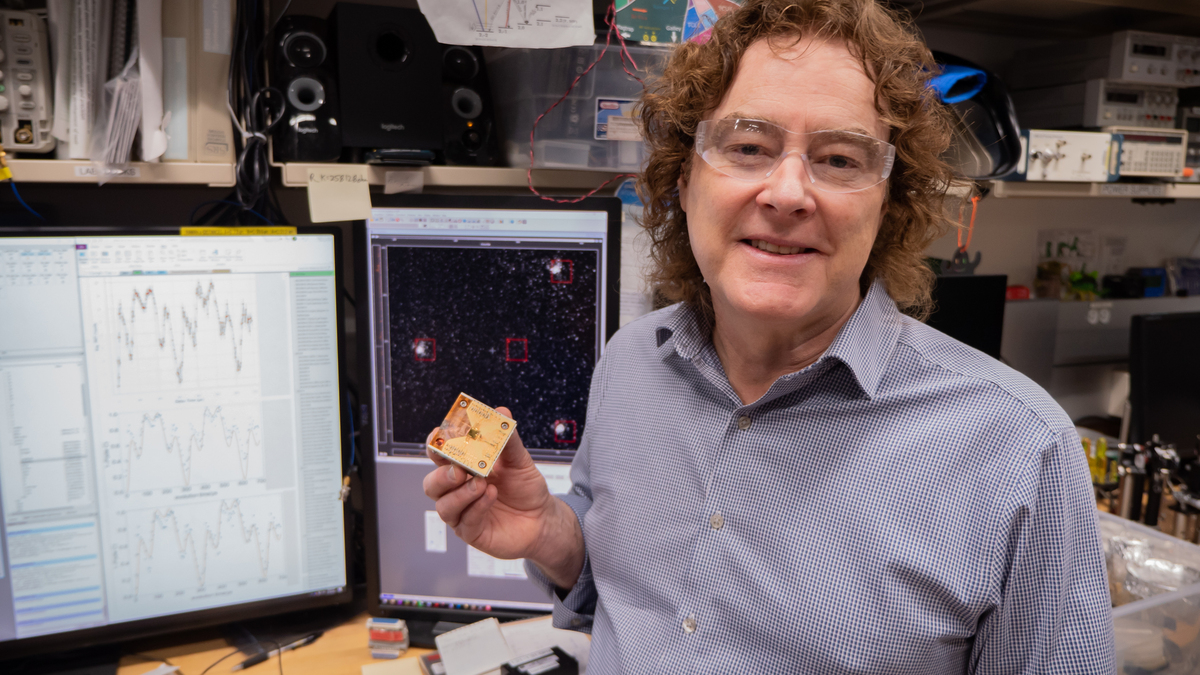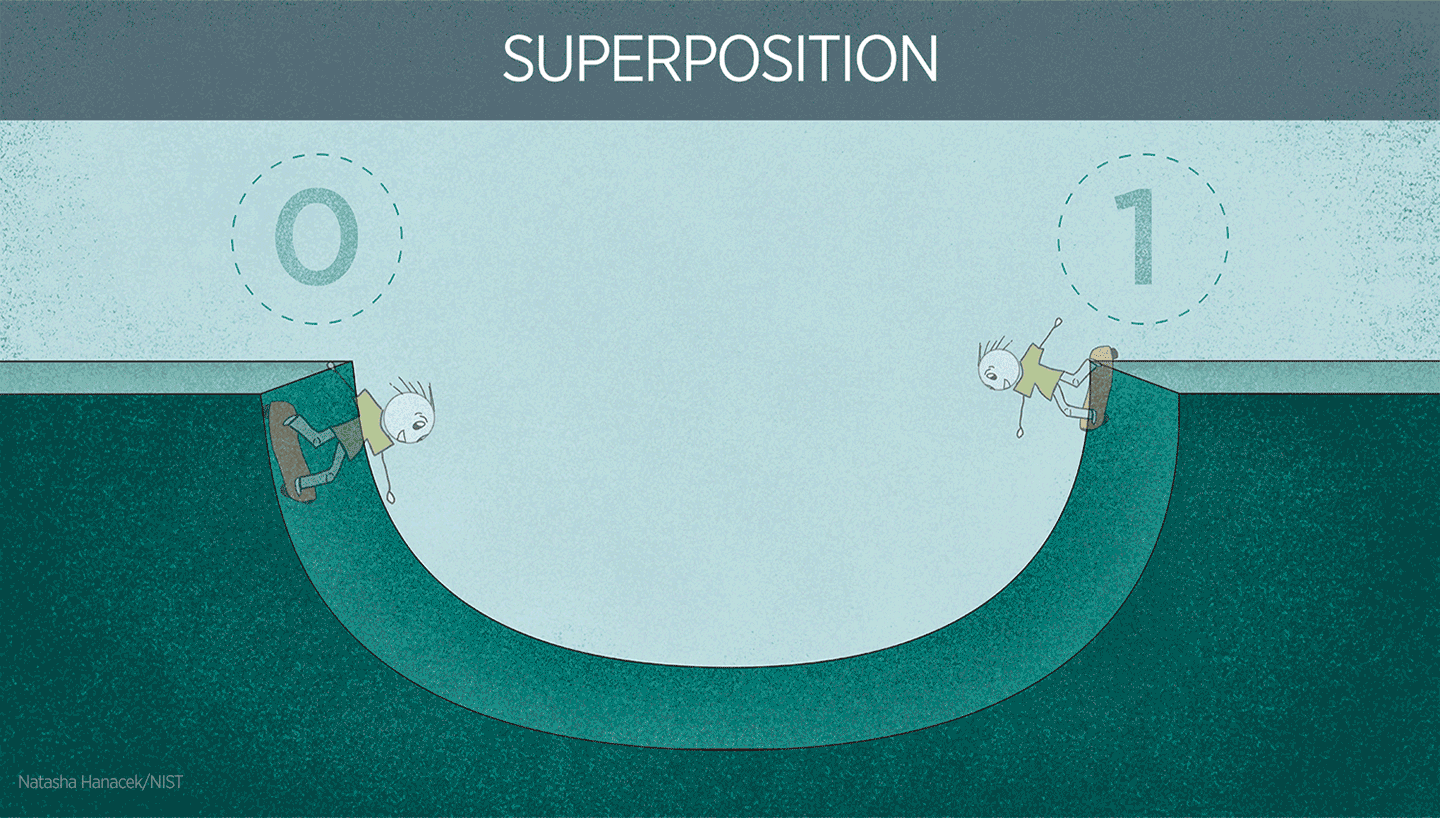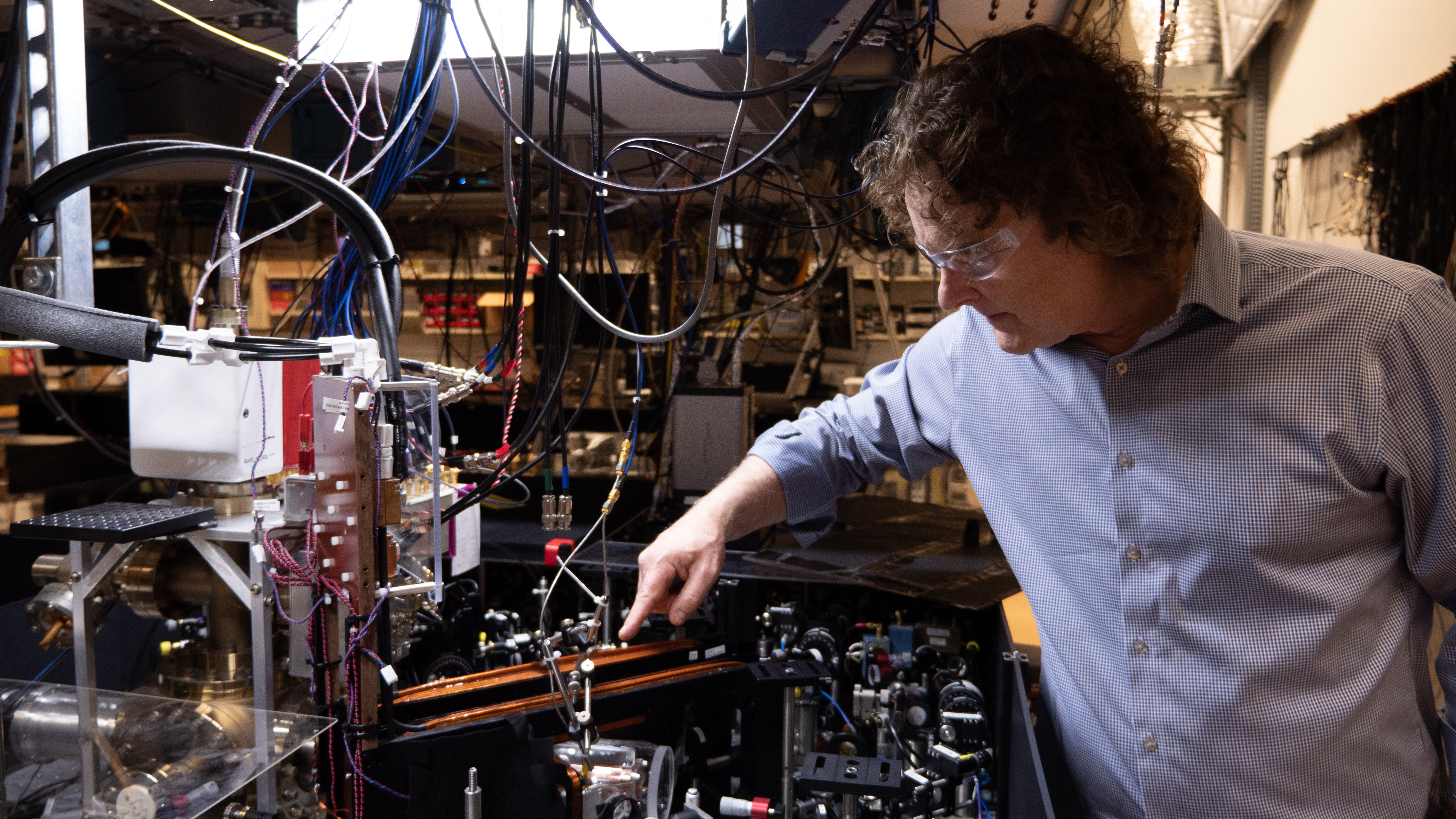Taking Measure
Just a Standard Blog

If you’ve gotten around with GPS, had an MRI, or tormented your cat with a laser pointer, quantum science is a part of your life.
Ahead of World Quantum Day this week, we asked Andrew Wilson, who leads NIST’s Quantum Physics Division, to explain just what exactly quantum science is and why it matters.
We’re celebrating World Quantum Day. Let’s start simply. When we say “quantum,” what do we mean by that?
Well, it means different things to different people. But it essentially comes down to using fundamental quantum properties to do great things. When people talk about using quantum, it generally comes down to two things:
- Quantum superposition is something that has two possible forms being in both of those forms to some extent at the same time.
- Entanglement means you’ve got at least two things that are always connected together; they have no independent existence anymore. Something that happens to one always affects the other. It’s kind of romantic!
Entanglement and superposition are resources for quantum computing. These are what make quantum computing powerful.
Why are scientists so interested in all things quantum?
I think in the early days of quantum physics, there were ideas like the laser. Quantum physics underpins the laser, and the laser turns out to be rather important. It supports the internet. Quantum also comes into things like MRI imaging and semiconductor chips. So, we rely on quantum behavior to understand how these things work. That’s quantum physics. This early version of quantum physics is called semiclassical physics. And a lot of technology based on this uses superposition. Today, this is widely referred to as Quantum 1.0.
But as we physicists kept working on quantum systems, and getting better at making and controlling these, we started thinking, OK, maybe we can do useful things with entanglement. So, we added entanglement to the toolbox. That’s Quantum 2.0. Quantum 2.0 is about trying to capture the advantages and the practical applications of both superposition and entanglement. We’re really trying to see how we can make entanglement practical. There will have to be many scientific breakthroughs, including fundamental science, for this kind of technology to be ubiquitous in our economy and society.
At the same time that progress was being made in labs, some clever people realized that this toolbox could be used for information processing. Quantum computing emerged from the “coming together” of clever ideas and advancements in labs, a mix of quantum physics and information science.
We can develop quantum computers, but what else can we do?
We can also use superposition and entanglement for improved sensors and communications. We can make quantum sensors that measure things more precisely than classical physics allows. We can communicate information in quantum form that is resistant to eavesdropping. The challenge with these Quantum 2.0 things is making them practical. There is much work to do, and it’s very exciting to see the progress being made.
Another thing that makes quantum interesting is that there are potential applications in many areas, far beyond physics. There are applications being pursued in chemistry, biology, health care, finance, transport, manufacturing and so forth. It can be a very interdisciplinary field. That makes it hard because each one of us only has a certain amount of expertise. On the other hand, the cool part is you get to collaborate with people who are experts in other things and learn from them.

When you hear the word “quantum,” it sounds so abstract. Where does it show up in our everyday lives?
People do tend to think of quantum as sort of a weird and abstract thing. Because most of the stuff we deal with in the real world — pens, cars, coffee cups, etc. — those things don’t behave quantum mechanically in our everyday experience. Because quantum mechanics is not an everyday experience for most people, it can seem very strange.
But quantum is not just a theory, it’s just the way nature is. For those of us who work with this every day, it’s not mysterious or abstract. It’s as practical as anything else that we deal with during the day, including pens and coffee.
As I said, there are lots of practical applications of quantum. There are parts of electronics that rely heavily on quantum mechanics. Health care, communication, lots of technology relies on it.
One of the most common practical applications is timekeeping. The only reason you’re able to have a GPS on your phone or in your car is that you’ve got some atomic clocks in satellites. You may not know it, but you’re using quantum superposition in those clocks, making sure you can figure out where you’re going. So if I’m supposed to be meeting my wife at a restaurant, and I don’t know where it is, I’m relying on quantum mechanics to get me there, to achieve that goal. This is an everyday use of quantum mechanics, looking at our phones and figuring out where we’re going.
Why is it important to continue to research quantum science?
Studying quantum may lead us to the next big thing, or a bunch of things, whatever the next laser or GPS may be. There are a lot of ideas out there for how we can use quantum, and people are frantically trying to figure out:
- What can quantum technology be used for?
- How can we advance quantum technology so that it can be used for practical problems?
Economies are affected by Quantum 1.0, and there’s a high probability that Quantum 2.0 will have another transformational impact. There are so many ideas floating around that people are excited about; that’s why we’re doing this.
NIST specifically is doing this because we do measurement science to help spur innovation and competitiveness. People come to NIST with measurement problems, and often, we can overcome classical barriers to this measurement problem using quantum mechanics. That’s why NIST has been a leader in quantum mechanics since its earliest day because of the precision measurement involved.
The more you can measure something very precisely, the more you can make improvements to that technology. So there’s a lovely cycle of measuring more precisely, improving the technology, and measuring more. But at some point, we hit the limit of the measurement scheme we’re using, and we have to develop a new approach. Measurement science is key to advancing technology. That’s how I think about it.
Where did your fascination with this area of research come from?
When I was a kid, I liked building and fixing things. My bike would break, and it was the way I got around, so I was highly motivated to figure out how to fix it. So, I pulled things apart and put them back together again. I tinkered with things. I had some people around me who had knowledge of electronics, and I started building little simple circuits or simple gadgets with little motors or lights.
I wanted to understand how things work. Why is it doing this thing? And I was curious and got drawn into things. It helps to have a high tolerance for being confused. I want to say that physicists are perpetually confused about the latest thing they’re thinking about, and that is the way we learn, right? You’re confused today. You figure something out, and you’re very happy about this, but you’ll be confused by something new tomorrow!
When I got into the lab, I found I was pretty good at fixing things, making things work, and understanding why things don’t work and fixing those things. So, when you have that kind of inclination, you wind up as an experimentalist.

And as for quantum, it’s just cool, right? For example, I do a lot of work with lasers. There’s almost nothing cooler than lasers. If you’ve only seen the little red dots of a laser pointer, come into some of these labs, and you’ll see the most incredible colors in nature. It’s basically a rainbow on steroids. They’re so beautiful and just wonderful to be around. There’s also a profound sense of joy from seeing something that no one has ever seen before, sometimes a discovery that scientists have been seeking for decades.
The lab feels like a playground to me, albeit with a challenging scientific mission, hard work, long hours, occasional setbacks, and serious safety requirements that require careful following of protocols.
A lab is like Disneyland to an experimental physicist like me. When you’re in the lab and you see on your screen a signal, an image, a trace of something, after all that hard work, it’s just a reminder of how incredible nature really is. It’s better than any fiction book that’s ever been written in my humble opinion. This work just draws you in.
And of course, we’re not just tinkering around here, we’re mission-driven. We push very hard; it’s also a very competitive field. Many of us like to compete.
What is on the horizon for quantum science? What excites you about the future?
There’s a ton of really great science being done and quantum technologies being developed. We now do things in the lab routinely that even just a few years ago we only dreamed about being able to do and didn’t know how. We can implement important algorithms for quantum computing. We can build sensing-type devices with quantum performance far beyond what anyone has had before. We can communicate quantum information over greater distances and with better fidelity than ever before.
There are different sorts of quantum computers that many companies are now building. NIST is developing ideas and technologies that these companies will need in the future as they try to extend the capabilities of their machines.
Many things about how quantum technologies might evolve remain unclear, but we as scientists are just very patient, slowly chipping away at problems. When you’re chasing after something really important, that can be massively transformative, you have to have a lot of resilience and grit.
Scientists hammer things out — improve things by factors of two — year after year. It’s like a running a marathon. We have our 100-meter races, too, but quantum is really a sustained effort. NIST has had a sustained quantum effort for decades now.
As we begin to work on potential applications of quantum, we’re learning so much about things beyond quantum physics. It’s exciting to support companies that are part of the emerging quantum industry and to see the creative ways they are advancing technologies. Perhaps we will be able to look back at this moment in time as when quantum revolutionized technology, in the same way that silicon chips and integrated circuits did in the 1960s and ’70s. I hope so. We shall see.





